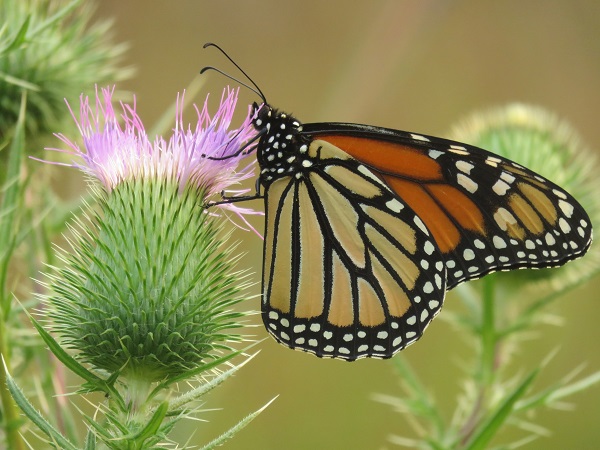
Photo taken by Virginia Coburn at Bluff Creek SNA on a Foundation Field Trip
The Natural Resources Foundation of Wisconsin is proud to announce our recent partnership with the Monarch Joint Venture (MJV), a collaborative effort with more than 50 partners including government agencies, universities, and nonprofit organizations working to conserve, protect, and promote the monarch and its habitat throughout the country.
The monarch butterfly (Danaus plexippus) is arguably America’s most recognizable insect. Despite its popularity, monarch populations have been reduced by a staggering amount—researchers estimate that 80 percent of the eastern population (east of the Rocky Mountains) has been lost in the last decade.
Loss of habitat, pesticide use, and climate change are just a few of the factors impacting the North American monarch population.
We want to ensure that our future generations can cherish the beauty of a monarch making its way south for the winter. Through our partnership with the Monarch Joint Venture, our Foundation has committed to conserving and creating monarch habitat throughout the state, while educating the public on the important environmental roles played by monarchs and other pollinators.
We hope you’ll join our effort to protect monarchs—here in Wisconsin, and across the country. While it’s unlikely that the population will every fully recover, there are some simple things you can do right now to start making a difference.
Create monarch habitat
Wisconsin is one of the many states across the country to which the monarchs return each spring to breed and lay eggs. The monarch is dependent on various milkweed species to lay these eggs, but milkweed plants are becoming increasingly rare throughout Wisconsin and other states in the Midwest.
One of the most important things you can do is provide habitat for monarchs to breed. While prairies and milkweed-rich wetlands are considered prime habitat for breeding monarchs, by planting milkweed in your own backyard, you help build a bridge to other habitats.
Identify areas that could be transformed into monarch habitat, like lawns or edges of your property. You can use native plant plugs or re-seed a small area with milkweed. Native plantings are not only good for monarchs, but have low long-term maintenance costs and provide other environmental benefits like water filtration and erosion control.
Several types of milkweed are native to Wisconsin and attract to many species of butterflies, including monarchs.
- Common milkweed (Asclepias syriaca)
- Swamp milkweed (Asclepias incarnate)
- Butterfly weed (Asclepias tuberosa)
- Whorled milkweed (Asclepias verticillata)
- Poke milkweed (Asclepias exaltata)
Resources:
Pollinator Conservation Resources.
Locate a milkweed seed supplier in your area.
Join a citizen science project
Citizen science projects are a critical way for scientists to learn about monarchs and their decline. There are a variety of projects to get involved in, depending on your interest and availability.
Journey North. This is a simple, online way to report sightings to track monarch migration and milkweed phenology.
Monarch Larva Monitoring Project. Volunteers establish a milkweed monitoring site and observe it weekly for monarch eggs and caterpillars and do an annual assessment of the milkweed density (additional, optional activities available for this project).
Monarch Watch. This project operates tagging programs where volunteers put a small, unique tag, or sticker, on butterflies to better understand migration.
Educate others
There are many opportunities for you to educate others about monarchs and advocate for monarch conservation. Provide your community with information about what they can do to help monarchs by giving presentations to local youth groups, garden clubs, or other organizations.
If you participate in a citizen science monitoring project, get others involved by training others to collect data at their own site(s).
Another way to educate others is to draw attention to your monarch habitat(s) by displaying educational signs or structures in your garden or habitat. Displays may inspire passers-by to take part in monarch monitoring or conservation activities of their own.
Lastly, encourage your mayor to sign the National Wildlife Federation’s Mayors’ Monarch Pledge. Communities that commit to taking conservation actions (e.g. adding habitat, changing mowing practices, reducing pesticide use, etc.) can sign on to the pledge.
Join us on a Foundation Field Trip!
NRF will be offering nine monarch-related field trips throughout 2017 to celebrate our partnership with the MJV. You can look for them in our 2017 Field Trip Guidebook, due out in March!
Donate
Your support helps provide critical monarch habitat in Wisconsin, and educates people on monarchs. Visit wisconservation.org/donate and select “Endangered Species Protection” in the Special Purpose section.
Stay in the know
If you are interested in learning more about monarch conservation through the Monarch Joint Venture, please visit www.monarchjointventure.org. Stay tuned for updates from the Natural Resources Foundation by following the WisConservation blog, signing up for our e-newsletter, and following us on social media.
